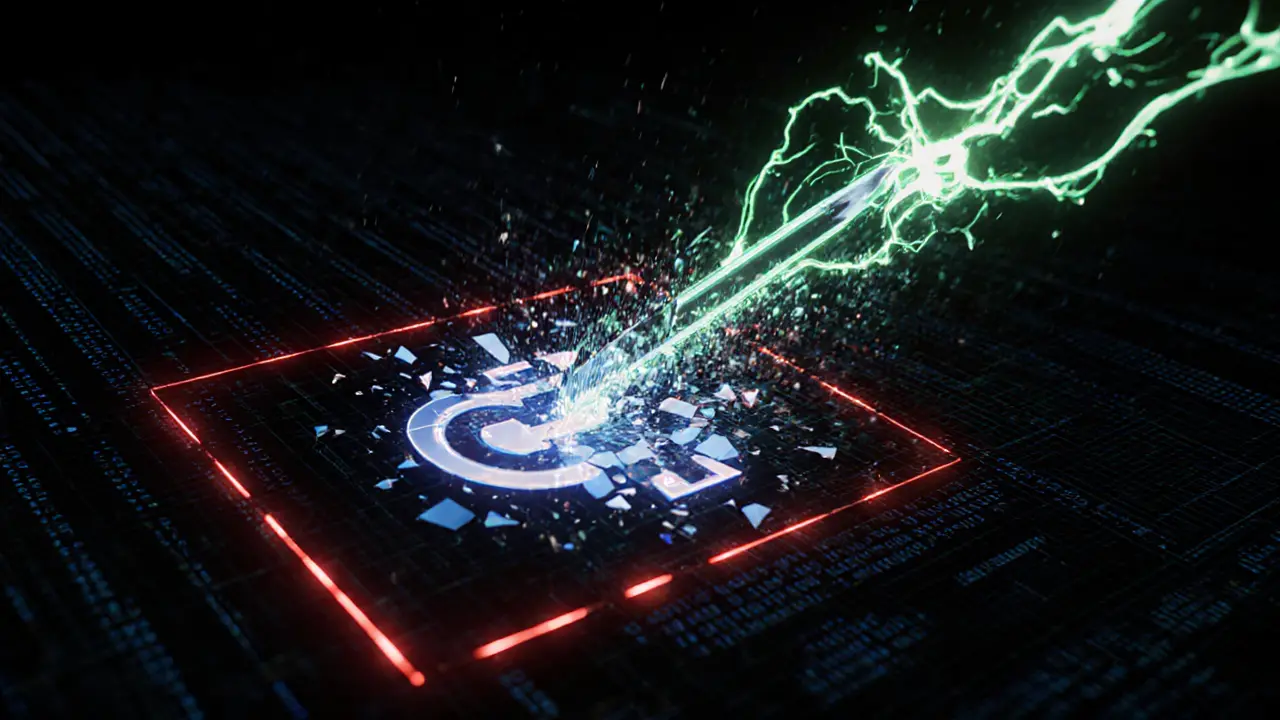Quantum Computing Risk Estimator
Quantum Risk Assessment
Timeline Projection:
When we talk about the Quantum Computing Threat to Blockchain a looming risk where quantum computers could break the cryptographic locks that keep blockchain networks safe, the headline often reads like science‑fiction. Yet the math behind it is real, and the clock is already ticking. This article unpacks why quantum machines matter for blockchain, when the danger becomes practical, and what developers, investors, and everyday users can do right now to stay ahead.
Why Quantum Computing Ups the Ante
Quantum Computing uses qubits that can exist in multiple states simultaneously, enabling certain calculations to run exponentially faster than on classical chips. The breakthrough isn’t speed for everyday apps; it’s the ability to solve problems that classical computers deem intractable. Shor’s algorithm, a quantum routine discovered in 1994, can factor large numbers and solve discrete‑logarithm problems in polynomial time. Those two problems are the backbone of the asymmetric cryptography that secures blockchain transactions.
Blockchain’s Cryptographic Bedrock
Most public blockchains rely on RSA an encryption scheme based on the difficulty of factoring large prime numbers or Elliptic Curve Cryptography (ECC) which depends on the hardness of the elliptic‑curve discrete logarithm problem. When you send Bitcoin or interact with a smart contract, you sign the transaction with a private key. The network verifies that signature with the corresponding public key, which is openly visible on the ledger. As long as deriving the private key from the public key remains computationally impossible, the system stays secure.
Shor’s Algorithm: The Break Point
Shor’s algorithm can crack both RSA and ECC in dramatically fewer steps. Rough estimates from 2022 research suggest a quantum computer with about 13million well‑controlled qubits could factor a 2048‑bit RSA key within a day. For Bitcoin’s secp256k1 ECC keys, a machine capable of running Shor’s algorithm for roughly 30minutes could forge a valid signature. The critical metric isn’t just raw power; it’s whether the quantum device can finish the computation before a transaction confirms-typically under 10minutes for Bitcoin.
How Soon Could It Happen?
Today's best quantum chips, like Google’s 105‑qubit Willow processor, are impressive but still far from the millions‑of‑qubits threshold. Error correction remains the biggest hurdle; without fault‑tolerant architectures the computation falls apart. However, qubit counts have been doubling roughly every 1.5‑2years, echoing the early growth of classical computers. If the trend continues, many experts project that a "break‑ready" machine could appear sometime in the 2030s. That window may sound distant, but the blockchain community treats a decade as a short horizon because assets are long‑term stores of value.

Mitigation Strategies: Going Post‑Quantum
The most promising defense is Post‑Quantum Cryptography (PQC) a suite of algorithms designed to resist attacks from both classical and quantum computers. PQC families include lattice‑based schemes (e.g., Kyber, Dilithium), hash‑based signatures (e.g., XMSS, SPHINCS+), and multivariate quadratic equations. These problems remain hard even when a quantum computer runs Shor‑style algorithms.
Implementing PQC on a live blockchain isn’t a simple swap. Nodes must agree on new verification rules, wallets need updates, and the network must avoid a hard fork that could split the community. Some projects are already testing hybrid approaches-using both classic ECC signatures and a PQC signature on each transaction-to give users a safety net while the ecosystem transitions.
Industry Moves and Experiments
Ethereum has launched a research track called "Ethereum Quantum-Resistant Roadmap" to explore lattice‑based key derivation and signature formats. Hyperledger’s working group is drafting a quantum‑safe module that can be plugged into permissioned ledgers. Meanwhile, D‑Wave has demonstrated a proof‑of‑concept blockchain running across four annealing quantum computers, showing that quantum hardware can even help with hashing and proof‑of‑work while consuming far less electricity. Those experiments are early, but they signal a shift from "react after the attack" to "design with the attack in mind".
Practical Steps You Can Take Today
- Avoid address reuse. Re‑using a Bitcoin address reveals its public key after the first spend, giving a quantum adversary a target. Fresh addresses keep the public key hidden until it’s needed.
- Prefer wallets that support Bitcoin a blockchain that currently uses ECC (secp256k1) for signatures and are already rolling out Taproot or other upgrades that make future PQC switches smoother.
- Stay informed about network upgrades. When a blockchain announces a hard fork to a quantum‑safe algorithm, consider moving funds before the deadline.
- Follow reputable sources for quantum‑computing milestones. A sudden jump in qubit counts or error‑correction breakthroughs can change the risk profile overnight.
Comparison of Classical and Post‑Quantum Algorithms for Blockchain
| Algorithm | Mathematical Basis | Quantum Resistance | Current Use in Blockchain |
|---|---|---|---|
| RSA‑2048 | Integer factorization | Broken by Shor’s algorithm | Rare (mostly for TLS) |
| secp256k1 (ECC) | Elliptic‑curve discrete log | Broken by Shor’s algorithm | Bitcoin, Ethereum (pre‑upgrade) |
| Kyber (Lattice‑based) | Hardness of learning with errors | Resistant (no known quantum attack) | Emerging, pilot in Ethereum research |
| Dilithium (Lattice‑based) | Shortest vector problem | Resistant | Prototype for digital signatures |
| SPHINCS+ (Hash‑based) | Stateless hash trees | Resistant | Experimental, low‑performance proof‑of‑concept |
Looking Ahead: The Bigger Picture
The quantum threat isn’t limited to cryptocurrency. TLS, VPNs, and any system that relies on RSA or ECC will need to migrate to PQC. The blockchain arena is just the most visible battlefield because of the monetary value at stake. Coordinated standards work-like NIST’s PQC competition-will shape the algorithms that become industry‑wide defaults.
Ultimately, security is a moving target. By the time a million‑qubit breakout machine appears, the blockchain world will likely have already woven quantum‑safe primitives into its fabric. Preparing now-by adopting best practices and supporting research-keeps you on the safe side of that transition.

Frequently Asked Questions
When could quantum computers actually break Bitcoin?
Current estimates put the break‑point at a machine with roughly 13million logical qubits and full error correction. If qubit counts keep doubling every two years, many experts see that level emerging in the 2030s, though exact timing is uncertain.
What is a "harvest‑now, decrypt‑later" attack?
Adversaries capture encrypted traffic today and wait until a quantum computer can break the underlying algorithm. Once the machine exists, they decrypt the stored data, exposing past transactions or communications.
Can I switch my wallet to a quantum‑safe one today?
A few experimental wallets already bundle post‑quantum signature schemes, but they aren’t widely supported on mainnet. The safest interim step is to avoid address reuse and keep funds on platforms that plan PQC upgrades.
Do all blockchains face the same quantum risk?
Any chain that uses RSA or ECC for signatures is vulnerable. Some newer platforms are built from the ground up with lattice‑based keys, giving them a head start on quantum resilience.
How does D‑Wave’s quantum blockchain differ from Bitcoin’s proof‑of‑work?
D‑Wave used annealing qubits to perform the hashing step, dramatically cutting energy consumption. It’s a proof‑of‑concept, not a production‑grade network, but it shows quantum hardware can assist rather than threaten blockchain processes.


Jacob Anderson
March 8, 2025 AT 08:35Oh great, another apocalyptic prediction.
VICKIE MALBRUE
March 9, 2025 AT 04:02Even if quantum computers get faster we can adapt and keep things safe
Katrinka Scribner
March 9, 2025 AT 23:28Lol 😂 this is kinda scary but also kinda cool omg I think we’ll see some fixes soon
Oreoluwa Towoju
March 10, 2025 AT 18:55Start learning post‑quantum signatures now
april harper
March 11, 2025 AT 14:22The very foundations of trust tremble as the silent specter of quantum supremacy looms.
Kate Nicholls
March 12, 2025 AT 09:48True, but remember that practical attacks still need massive error‑corrected qubits.
Amie Wilensky
March 13, 2025 AT 05:15Well…; the reality is that; most blockchains; are still safe for now; however; we should monitor progress;.
Charles Banks Jr.
March 14, 2025 AT 00:42Yeah, because we all love reading semicolons for fun.
Waynne Kilian
March 14, 2025 AT 20:08Let’s focus on collaborative research to build quantum‑resistant standards that work for everyone.
Michael Wilkinson
March 15, 2025 AT 15:35If you think it’s a joke, you’re dead wrong.
Billy Krzemien
March 16, 2025 AT 11:02I recommend checking NIST’s post‑quantum roadmap; it’s a solid starting point.
Clint Barnett
March 17, 2025 AT 06:28When we talk about quantum threats, we must first acknowledge the sheer elegance of the underlying mathematics.
The dance of qubits across superpositioned states is a marvel that challenges our classical intuition.
Yet, this very elegance becomes the Achilles' heel for cryptographic schemes built on discrete log problems.
Shor's algorithm, in theory, can unravel RSA and ECC with a few thousand reliable qubits.
Current hardware, however, is still riddled with decoherence and gate errors that keep such attacks at bay.
Researchers are tirelessly improving error‑correction codes, inching us closer to the critical threshold.
Meanwhile, the blockchain community is not idle; several projects already experiment with lattice‑based signatures.
These schemes, while larger in key size, offer security that remains intact even against quantum adversaries.
Transitioning an entire network is non‑trivial, involving consensus upgrades and community coordination.
Nevertheless, a phased rollout-starting with soft forks that introduce quantum‑safe primitives-appears feasible.
Economic incentives can accelerate adoption, as miners and validators seek to future‑proof their investments.
Regulatory bodies may also play a role by mandating quantum‑resilience for critical infrastructure.
In the grand scheme, the timeline is uncertain; some predict viable attacks within a decade, others a half‑century.
What remains certain is that preparation today will mitigate shock tomorrow.
Thus, the prudent path is to stay informed, experiment with hybrid solutions, and support open‑source quantum‑resistant research.
Rajini N
March 18, 2025 AT 01:55In practice, upgrading to lattice‑based keys is straightforward and doesn’t require a blockchain rewrite.
Kate Roberge
March 18, 2025 AT 21:22Most hype is just noise, but ignoring quantum risks is even riskier.
Jason Brittin
March 19, 2025 AT 16:48Haha, keep calm, the future is bright 😎
MD Razu
March 20, 2025 AT 12:15The philosophical underpinnings of quantum computation force us to re‑examine what security truly means.
It is not merely a technical challenge but a societal one, demanding collective foresight.
While some dismiss the urgency, the trajectory of research suggests otherwise.
Deeply entrenched cryptographic assumptions cannot be left untouched.
Engaging both academia and industry ensures a balanced progression.
Consensus mechanisms must evolve alongside cryptographic primitives.
Only through open dialogue can we avoid a fragmented response.
Thus, the discourse should continue, unimpeded by premature optimism.
Ben Dwyer
March 21, 2025 AT 07:42Stay informed and keep your software up to date.